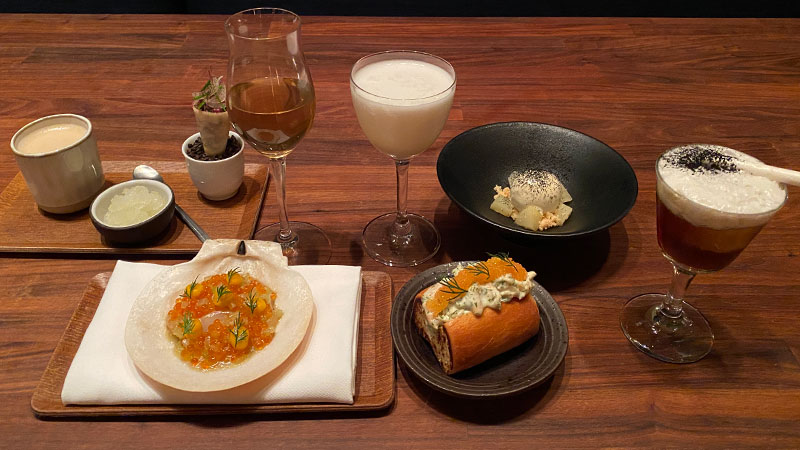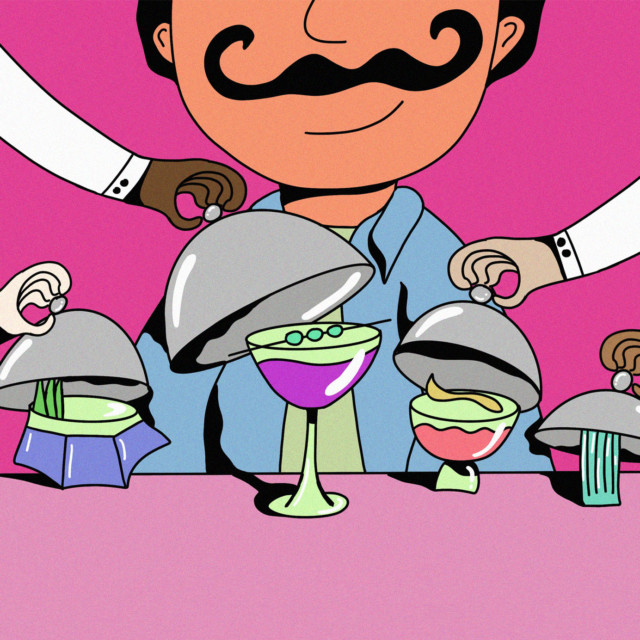My first visit to the tasting room bar at Washington D.C.’s Columbia Room in 2019 immediately struck me as being unlike any other experience I’d had as a bar-goer.
There was the space itself: 10 chairs lined up in front of a grandiose mural and a back bar conspicuous in its absence of any bottles of liquor — or anything for that matter. The velvet curtain through which guests passed to access the space only compounded the notion that the sitting would deliver as much theater as it would culinary delight. And said delights soon arrived in a flight of four seasonally focused cocktails, complete with interactive components and a paired curation of bites so tasty it seems a crime to call them “bar snacks.”
After enjoying the final sips of a dandelion-infused riff on the White Negroni, and polishing off the accompanying orange-beet curd dessert, I left the room so compelled by everything I’d just enjoyed, I was stunned more bars weren’t offering this distinctive brand of mixology.
Subsequent research taught me that Columbia Room was not, in fact, alone, though those offering cocktail tasting menus remained remarkably few and far between. From March 2020 onward, I then watched in horror as bars with such programs were among the first major casualties in the bar world — their offerings perhaps proving a square peg in the round-hole era of drinks to go and temporary outdoor seating.
After news emerged in early February 2022 that Columbia Room was also closing for good, new questions arose: Had Covid brought an end to cocktail tasting menus before they took mainstream flight? Or — conversely — has the pandemic actually created habits among drinkers that will make the experience more relevant and natural than ever before? And if so, are there bars still willing to offer it?
Crafting Cocktail Tasting Menus
Cocktail tasting menus take a unique approach to one unified concept: Over the course of a timed seating the bar serves a flight of cocktails that often arrive in smaller portions than normal to factor in the typically higher alcohol content of mixed drinks. Also helping on this front are small dishes that accompany the cocktails.
The upshot for drinkers is the opportunity to sample more creations during one bar visit than might otherwise be possible when ordering à la carte. There are practical advantages for bar operators, too. For example, when Derek Brown started planning the bar that would become the first of two Columbia Room iterations, he encountered the major obstacle of running a profitable program with just 10 seats in the space. Brown considered a model he’d seen in Japan, whereby drinkers pay a fee just to sit at the bar. “We realized Americans would not do that,” he says. “It’s just not part of our nature.”
Instead, Brown and team settled upon a menu that offered just four cocktails, the idea partly inspired by something Adam Bernbach was doing at Bar Pilar at the same time. The model evolved over the course of Columbia Room’s 12 years and two spaces, but was rooted in the notion that guests would pay a set fee for the whole experience — cocktails, food, and gratuity.
With reservations mandatory, the team knew well in advance how many of each drink they’d prepare on any given night. This allowed closer controls on ordering, and the opportunity to develop cocktails that utilized pioneering techniques and showcased seasonal ingredients, without great risk of waste.
So why close now, after weathering the choppiest waters of Covid-19?
Brown says the decision came not from pandemic complications, but instead reflected where he is in his life. Brown now rarely drinks alcohol, and has written eloquently about the path to his current relationship with booze. “I love the Columbia Room, but I felt like it had achieved what I set out for,” he says. “I wanted it to be one of the best bars in America. We won that accolade in 2017.”
View this post on Instagram
A Tricky Concept to Execute
Launched in 2011, Chicago’s award-winning The Aviary is another early adopter of the cocktail tasting menu. Part of Grant Achatz’s Alinea group, the bar offers avant-garde three-, five-, and seven-course food and mixed drink progressions in Chicago’s West Loop neighborhood. Alinea expanded this concept along with The Office, an accompanying speakeasy and vintage spirits tasting room, to New York in 2018.
Perched above Central Park on Columbus Circle, the dual bars ranked among the highest-profile early closures of the pandemic, with news emerging in April 2020. The company line was that the space’s fate had been sealed before Covid-19 changed the world forever, and the Aviary NYC had admittedly already endured some trying times during its New York stay.
Meanwhile, others seemed to defy all odds by introducing new ventures during the pandemic. Among them was Amor y Amargo, which in November 2020 announced the opening of a general store that would sell bitters, cocktail equipment, and pre-mixed drinks to go, as well as a new “Reserve” bar, that would serve co-owner Sother Teague’s interpretation of the cocktail tasting menu. With Teague’s background as a chef, the announcement provided particular excitement for in-the-know, cocktail-loving New Yorkers.
The space debuted in April 2021 but its run as a permanent fixture proved sadly short-lived. When I tried to secure an email reservation last September, a staff member told me they’d paused tasting menu experiences and were “operating as a bar, open without reservation,” and offered no explanation as to why. It’s worth noting that this was the height of the hospitality labor shortage crisis and, come October, cocktail tastings would return to the space in the form of “Two Weeks Notice,” a fairly regular event with four available seatings during one evening. (I’ve since had the luck of snagging a place at Two Weeks Notice and would recommend it to all.)
View this post on Instagram
As for the September evening in question — a special occasion I wanted to mark with something similar to the night I’d so enjoyed at Columbia Room — I scanned New York’s landscape and came up dry. Industry acquaintances recommended I inquire at Llama San, a Nikkei restaurant located in the West Village with an exceptional cocktail program.
The restaurant was serving an omakase-style menu with an optional wine pairing at the time. Importantly, they were happy and well versed in replacing the wines with cocktails. Though some of the finer details of the drinks and food are not quite crystal clear by this point — blame the literal and figurative intoxicating joy of the evening — Llama San’s aptitude for marrying food and mixed drinks shines bright in my memory.
“We’ve trained our floor staff and bartenders to think about cocktails the same way that they would think about offering a wine pairing to a guest,” says Natasha Bermudez, Llama San’s bar manager. “When we create a cocktail, we always ask ourselves: ‘What can we pair with this?’”
With such a clear culinary focus behind the bar, I wondered why cocktail pairings don’t appear as an on-paper, menu mainstay. The answer lies in the difference between operating a restaurant bar and a bar that offers food, Bermudez explains.
On a busy Saturday night, when there might be 75 seated guests, if a large portion of the dining room opts for paired cocktails, it could easily cause a bottleneck in service. Successful execution would require seamless communication between servers, bar staff, and kitchen, so that everything arrives with guests at the same time. Anyone who’s worked any of these positions will know how unrealistic that can be in the throes of a busy service.
Still, Bermudez urges potential guests to ask for it when dining at Llama San, or indeed any restaurant with a capable bar program. “Nothing against wine — I love wine — but I do think you’re going to receive the same culinary experience you would expect from food, but from the drinks,” she says.

A New Dawn for Cocktail Tasting Menus?
During the tail end of reporting this article, I received a timely mid-February email informing me that the two-Michelin-star Scandinavian New York restaurant Aquavit was to launch its own paired cocktail tasting menu, available in its 40-seat bar and lounge space. Later that month, I crossed the door as a guest of the restaurant, on what turned out to be the menu’s debut.
Given many others were scaling back or removing such operations, I later asked beverage director Patrick Reno what had so far been the biggest challenges of running the menu. “The operational difficulty is having to spend more intimate time with the guests when presenting the cocktail and explaining the food and why they pair well together,” he said. “It is more time consuming, but when you have passionate bartenders, this isn’t a problem.”
Once again, it’s not exactly a buyer’s market on that front right now — so here’s hoping things continue to ease up there. For the drinks devised by bartender Jeff Arnold, who worked closely with chef Emma Bengtsson, again confirmed the wonders of the pairing experience.
Tasted alongside a combination of scallop, carrot, trout roe, and seaweed, for example, the equal-parts mix of amaro, sweet vermouth, and dry vermouth — called the Crooked Diplomat — felt every bit a part of the dish as it did a complement. Both drink and food had the effect of heightening one another, elevating each bite and sip to more than the sum of their parts.
“This is a fun twist on pairing,” Arnold says. “We took the opportunity to create the cocktails first, then taste the chefs on the cocktails and give them the opportunity to create the food and put it in an order that is harmonious.”
It should be noted that other bars and restaurants continue to serve some form of cocktail flights: Thyme Bar, NYC; barmini, Washington D.C.; Pigtail, Chicago; The Wolf’s Tailor, Denver; and Botanist at Fairmont Pacific Rim, Vancouver, to name a few. No doubt there are others, but it’s tricky to discover cocktail tasting menus on Google because cocktail programs at restaurants with notable food tasting menus dominate search results.
Going beyond the lack of general public awareness and the difficulties we’ve already explored, other factors will likely always prevent cocktail tasting menus from reaching the mainstream. There’s price, of course, with most clocking in around $125 per person. And then there’s the reality this simply isn’t something most drinkers want on a day-to-day basis. (If anything, cocktail tasting menus profit from every-once-in-a-while encounters.)
On the flip side, there are reasonable arguments in favor of the cocktail tasting menu being more relevant now than pre-March 2020. Reserving a spot at a bar, with a limited timeframe and penalty for not showing up, is a much more familiar expectation these days. And surely the appetite for bar experiences that go above and beyond is greater than ever.
In the same way that multi-Michelin-star tasting menus endure, the pandemic has not, thankfully, spelled the demise of cocktail tasting menus — they’re just as difficult to come by and endure as before. Should you encounter the opportunity to experience one, I can’t recommend it highly enough.
This story is a part of VP Pro, our free platform and newsletter for drinks industry professionals, covering wine, beer, liquor, and beyond. Sign up for VP Pro now!
